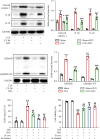Inhibition of PFKFB Preserves Intestinal Barrier Function in Sepsis by Inhibiting NLRP3/GSDMD
- PMID: 36589684
- PMCID: PMC9803577
- DOI: 10.1155/2022/8704016
Inhibition of PFKFB Preserves Intestinal Barrier Function in Sepsis by Inhibiting NLRP3/GSDMD
Abstract
Intestinal barrier dysfunction is associated with the occurrence and development of sepsis. Further, aerobic glycolysis plays an essential role in inflammation and cell death. This study is aimed at investigating the protective effect and mechanism of PFKFB3 inhibition on intestinal barrier dysfunction in sepsis mice. Sepsis mouse models were established by cecal ligation and puncture (CLP) in wild-type mice and Gsdmd-/- mice. The results showed that the expression of 6-phosphofructo-2-kinase/fructose-2,6-biphosphatase 3 (PFKFB3) in the small intestines was significantly upregulated in sepsis. 3-(3-Pyridinyl)-1-(4-pyridinyl)-2-propen-1-one (3PO), the specific inhibitor of PFKFB3, and Gsdmd gene knockout significantly inhibited the inflammatory response and cell death caused by sepsis, thus alleviating intestinal damage and barrier dysfunction. 3PO was also shown to significantly inhibit oxidative stress and NLRP3/caspase-1/GSDMD-dependent cell pyroptosis in the small intestines. The in vitro studies revealed that 3PO reduced NLRP3/caspase-1/GSDMD-dependent cell pyroptosis by inhibiting ROS. Taken together, our results suggest that PFKFB3 is involved in inflammation, oxidative stress, and pyroptosis during sepsis and enhances intestinal damage, which may provide important clues about the potential targets to be exploited in this highly lethal disease.
Copyright © 2022 Yongsheng Zhang et al.
Conflict of interest statement
The authors declare that the research was conducted in the absence of any commercial or financial relationships that could be construed as a potential conflict of interest.
Figures









Similar articles
-
[Effect of Liangxue Huoxue decoction on intestinal flora and NLRP3/caspase-1/GSDMD signaling pathway in mice model of sepsis-induced acute kidney injury].Zhonghua Wei Zhong Bing Ji Jiu Yi Xue. 2023 Mar;35(3):250-255. doi: 10.3760/cma.j.cn121430-20221122-01018. Zhonghua Wei Zhong Bing Ji Jiu Yi Xue. 2023. PMID: 36916336 Chinese.
-
Fudosteine attenuates acute lung injury in septic mice by inhibiting pyroptosis via the TXNIP/NLRP3/GSDMD pathway.Eur J Pharmacol. 2022 Jul 5;926:175047. doi: 10.1016/j.ejphar.2022.175047. Epub 2022 May 21. Eur J Pharmacol. 2022. PMID: 35609679
-
UCP2 knockout exacerbates sepsis-induced intestinal injury by promoting NLRP3-mediated pyroptosis.Int Immunopharmacol. 2024 Nov 15;141:112935. doi: 10.1016/j.intimp.2024.112935. Epub 2024 Aug 18. Int Immunopharmacol. 2024. PMID: 39159561
-
Shenhuangdan decoction alleviates sepsis-induced lung injury through inhibition of GSDMD-mediated pyroptosis.J Ethnopharmacol. 2024 Jan 10;318(Pt B):117047. doi: 10.1016/j.jep.2023.117047. Epub 2023 Aug 14. J Ethnopharmacol. 2024. PMID: 37586442
-
[The role of miR-135b-5p in inhibiting mice acute lung injury (ALI) induced by sepsis and its mechanism].Zhongguo Ying Yong Sheng Li Xue Za Zhi. 2022 Jul;38(4):366-372. doi: 10.12047/j.cjap.6263.2022.069. Zhongguo Ying Yong Sheng Li Xue Za Zhi. 2022. PMID: 36414563 Chinese.
Cited by
-
GLP-1R activation attenuates the progression of pulmonary fibrosis via disrupting NLRP3 inflammasome/PFKFB3-driven glycolysis interaction and histone lactylation.J Transl Med. 2024 Oct 21;22(1):954. doi: 10.1186/s12967-024-05753-z. J Transl Med. 2024. PMID: 39434134 Free PMC article.
-
Evaluation of glycyrrhetinic acid in attenuating adverse effects of a high-fat diet in largemouth bass (Micropterus salmoides).Anim Nutr. 2024 Sep 23;19:248-260. doi: 10.1016/j.aninu.2024.09.002. eCollection 2024 Dec. Anim Nutr. 2024. PMID: 39640558 Free PMC article.
-
Glycolysis: an emerging regulator of osteoarthritis.Front Immunol. 2024 Jan 9;14:1327852. doi: 10.3389/fimmu.2023.1327852. eCollection 2023. Front Immunol. 2024. PMID: 38264652 Free PMC article. Review.
-
Itaconate: A Potent Macrophage Immunomodulator.Inflammation. 2023 Aug;46(4):1177-1191. doi: 10.1007/s10753-023-01819-0. Epub 2023 May 4. Inflammation. 2023. PMID: 37142886 Free PMC article. Review.
-
PFKFB3 Inhibitor 3PO Reduces Cardiac Remodeling after Myocardial Infarction by Regulating the TGF-β1/SMAD2/3 Pathway.Biomolecules. 2023 Jul 3;13(7):1072. doi: 10.3390/biom13071072. Biomolecules. 2023. PMID: 37509108 Free PMC article.
References
MeSH terms
Substances
LinkOut - more resources
Full Text Sources
Medical
Molecular Biology Databases
Miscellaneous

